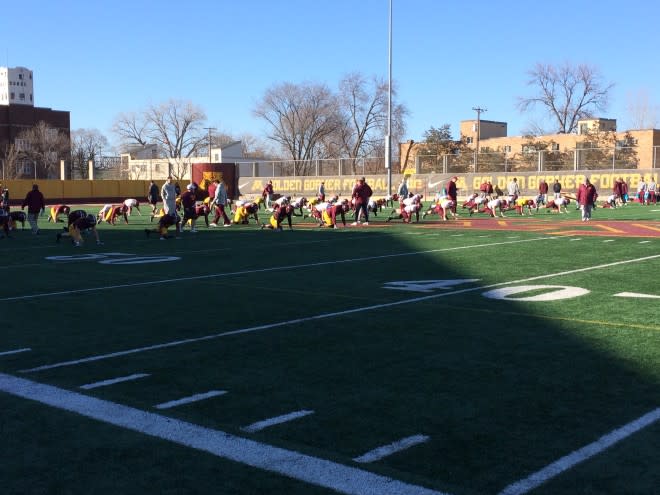Fleck practices what he preaches in practice
Also read: Practice Report: March 28 ($) // Practice Report Pt. 2: March 28 ($)

With Matt and Connor breaking down Tuesday's practice with what they saw from a personnel perspective I figured I would approach my write up differently. Instead of looking at the practice with an eye on individual players, here are some observations from more of an overall afternoon's prospective.
This is the first practice I have seen since P.J. Fleck became the Minnesota Gophers head football coach. The first thing I wanted to see was if Coach Fleck's press conference and interview enthusiasm really did cross over to the field. It took all of about thirty seconds to see that it did.
Fleck was all over the field. He often ran from station to station and was on a portable microphone so his voice could be played through a speaker system to be heard be anyone at any time.
Like Fleck, the practice was fast-paced from the word go. Even the students who were spotting the ball between plays needed to sprint to get out of the way in time for the next play.
Each section of practice was short. Everyone got in reps and got out. The fast pace of practice seemed to have multiple benefits.
"With our tempo, we need to condition during football, not just conditioning at the end, just to run to run," Fleck said. "We are going to condition while we play football."
The staff also uses the pace to simulate game situations. At seemingly random times Fleck would call out a command, and everyone would drop everything, and the field goal team would rush out onto the field, line up on the fly and get a kick into the air before a coach finished a countdown.
The practice pace is ramped up, but Fleck doesn't think the practices are fast enough.
"We need to get fourteen or fifteen more minutes cut off (of practice)," Fleck said. "It is the downtime. When the horn blows (to signal a new section of practice) – we go. We are not even close to the change of pace we need when that horn blows."
"If we can cut down ten seconds between each rep during individual drills," Fleck continued, "that adds up over the course of an hour and a half practice."
One thing I noticed was how the quarterbacks practiced. While some positions have to have guys wait their turn, quarterback is not one. When one quarterback was running the offense, the others would stand a few yards behind the quarterback doing the live drill and mimic the footwork and fakes of the actual quarterback.
There was also a sense of competition during practice. Early on in practice, the coaching staff ran a one on one tackling drill. All the offensive guys lined up on one side of the field with the defensive guys facing them about five yards apart. In between, they had a series of running back versus linebacker or receiver versus defensive back one on one drills.
The drill took place on the five-yard line. If the offensive player scored, one point was earned for the offense. If the offensive guy could not score, it was a win and a point for the defense. After each play, the winner would get mobbed by his offensive or defensive teammates. I don't know what the winning unit when the series of ten or so one on one battles was over, but the reaction of each win made it seem like they were playing for something. However, with the overall feel of the practice, they could have been simply competing for their unit's pride.
I don't know how much the enthusiasm and pace of practice will translate into wins on the field, but after watching one practice, it was obvious Fleck practices – in practice – what he preaches.

